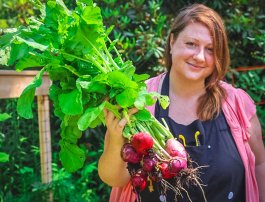
If you want a happy garden, you can’t really set it and forget it. If you ignore your garden for a few days in mid-summer, especially if you go away on vacation, you might come back to a jungle! And even if you’re not skipping a few days of upkeep in the middle of summer, there are lots of mid-summer garden chores that will creep up on you quickly.
I like to set aside time every week to do a thing or two, especially picking the suckers on my tomatoes and weeding (which seems to be a constant job), but the rest of the items on this list of garden chores don’t need to be done weekly, they can be done once or twice. Skip them and your garden might be totally fine, but you’ll certainly reap the benefits if you stay on task.
When we filmed the video above, the heat index in my part of New England was 106 degrees with very high humidity. Unless you want to look like a melted popsicle (like I did by the end of it), I’d recommend waiting for a cooler, perhaps 75-degree day if at all possible.
Before we get started, I have to warn you that when pruning, make sure you use an alcohol wipe or sanitize your pruning shears in between plants so that you don’t spread any disease from one plant to the other. This is the exact time of year when people go pruning like good little gardeners and end up infecting all their crops instead of helping them.
Summer Garden Chores
1. Prune
Indeterminate tomatoes especially, will get wild starting at the beginning of July and continue to get unruly if you don’t do a little trimming. You’re the boss, so if you have branches that aren’t flowering that you want to trim off, you can do so!
2. Deadhead
Make sure to pop the flowers off your marigolds, basil, oregano, and other flowering plants to encourage more growth. Thyme is a little tricky especially a large batch, so I tend to just let it flower, and the leaves taste just as good! Trim your herbs all summer to keep them growing.
3. Pull
You can’t win them all. If you have a batch of peas and some of them just couldn’t hang and turned yellow or brown, give them a pull. Do the same for any other seedlings that just never took off. This helps keep any fungus or disease from spreading in your soil.
4. Mulch
If weeds are getting crazy, add some mulch, even if you already mulched earlier in the season.
5. Clean
Weed, weed, weed. Also, as your root veggies like radishes mature, make room in your garden beds by pulling them up as soon as they’re mature. Once the summer gets hot, it’s easy for them to bolt and turn to flower because they prefer cooler soil temperatures.
6. Clear Disease
My actual nemesis, powdery mildew, should be pruned off with clean shears as soon as you see it, otherwise, it will infect the rest of the plant. Watering with a sprinkler and too much rain on the leaves is usually the culprit, which is why if you’re growing squash and other vining plants, it’s better to use drip irrigation. Here’s a video of the drip irrigation system I set up this summer.
7. Pluck
If you want your beans to keep growing all summer long, make sure you continue to pull the fruits of their labor. The more you harvest, the more your plants will make and replant if needed. This applies to most other vegetables as well.
8. Re-garden
All your cooler-weather-loving crops like lettuce will appreciate being cleaned out by now, but you can continue growing new heads all summer, as they grow new heads every 30 days. Radishes are another quick crop you can plant all summer long. Spring-planted bush beans will be tapped out and withering by mid-July, so if that’s happening, you can pull them out and plant a new crop at this point because many varietals take less than 60 days to create more beans for the fall.
9. Fertilize
Fertilize away. At this point, some of your plants might be telling you what they need by the color of their leaves and stems. Check out our plant, herb, and fruit gardening guides for tips on individual plants.
10. Start your fall garden
Seeds germinate quickly in the summer because the soil is warm, so as long as you keep your seeds moist, you can begin planting for the fall. Add more compost and nutrients to the soil, because your spring crop probably depleted much of the nutrients. Cucumbers and snap peas – same. You should also add fall crops like carrots, turnips, beets, kale, or more radishes!
Also, if you’re growing potatoes, you can pluck a few early birds, called “new potatoes”, which are smaller with thinner skin. They’re great little roaster and creamer potatoes!
Which summer garden chores would you add to this list? What did I miss?


 Previous
Previous

